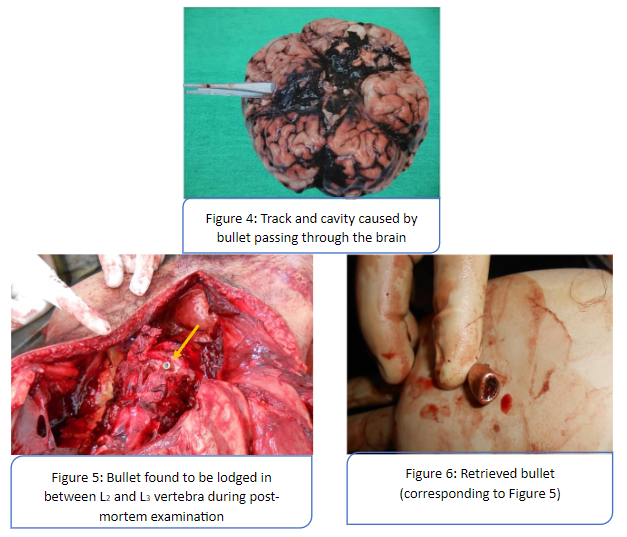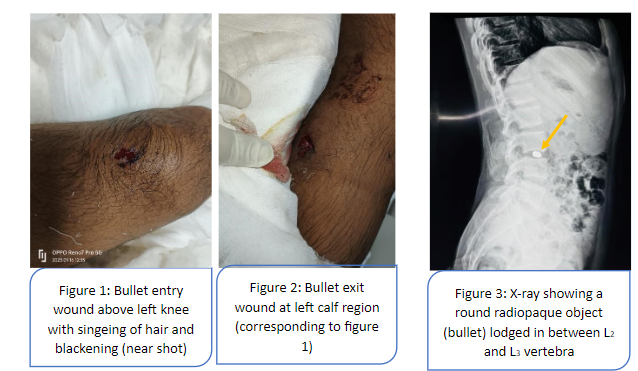Introduction
Forensic medicine is a vital component in solving criminal cases, utilizing scientific methods to determine the cause of death by analysing evidence that intersects medical and legal domains. This field includes various specialties, such as pathology, toxicology, and anthropology, to extract crucial information that aids law enforcement and judicial systems in ensuring justice and maintaining public safety.
Ballistics, a specialized area within forensic science, focuses on the study of firearms, projectiles, and gunshot injuries. By examining elements like bullets, cartridges, and gunshot residue, ballistics experts can identify the type of weapon used, the distance between the shooter and the target, and the bullet's trajectory. Such insights are critical in crime scene reconstruction, suspect identification, and determining the sequence of events leading to injuries or fatalities.
In forensic work, ballistics provides essential evidence linking physical materials to specific firearms, helps assess the extent of injuries from gunshots, and offers valuable context surrounding shooting incidents. Through the combination of scientific analysis and investigative methods, ballistics professionals assist law enforcement in resolving complex cases, identifying those responsible, and securing convictions through solid forensic evidence.
In essence, the inclusion of ballistics in forensic investigations enhances the precision, reliability, and efficiency of determining causes of death in criminal cases. Its role in deciphering firearm-related evidence and reconstructing shooting scenarios highlights its importance in forensic medicine and its contribution to the pursuit of justice.
The Role of Ballistics in Injured Patients Receiving Medical Treatment
Ballistics plays a pivotal role in cases where gunshot victims survive and require medical intervention. Forensic ballistic analysis provides critical insights that inform medical care while also aiding legal investigations.
Wound Evaluation in Hospitalized Patients: Understanding a bullet’s ballistic characteristics helps healthcare providers assess the severity of injuries and anticipate complications. For example, high-velocity bullets, such as those from rifles, typically inflict more extensive tissue damage than lower-velocity bullets, such as those fired from handguns. Knowing the ammunition type used aids in surgical planning, especially when bullet fragments remain in the body. By examining gunshot wounds for entry and exit points, tissue damage, and bullet fragmentation, medical professionals can estimate the extent of internal injuries and foresee potential complications during recovery.
Bullet Retrieval and Analysis: In cases where a bullet is lodged in a patient, medical teams often collaborate with forensic experts to safely remove the projectile. Once retrieved, the bullet can be analysed to match it with the firearm used, offering essential evidence for criminal investigations. Additionally, examining whether a bullet fragmented upon impact provides valuable information, as some ammunition types are more prone to fragmentation, complicating both medical treatment and forensic analysis.
By integrating forensic expertise and ballistic data, healthcare providers can create more targeted treatment plans, reduce risks of secondary injuries or infection, and support the rehabilitation of patients affected by firearm incidents.
The Role of Ballistics in Determining the Cause of Death
One of the primary applications of ballistics in forensic medicine is determining the cause of death in shooting victims. Gunshot wounds can often be fatal due to the damage they cause to major organs, blood vessels, or the central nervous system. Ballistic analysis helps forensic pathologists understand how these injuries resulted in death.
Wound Ballistics: This aspect of terminal ballistics is crucial for understanding the nature of gunshot injuries. When a bullet enters the body, it creates a permanent cavity (the bullet’s path) and a temporary cavity (the displacement of tissue caused by the bullet’s passage). Forensic experts analyse these wounds to assess the bullet’s speed, calibre, and entry angle, which helps determine whether the gunshot directly caused death or if other factors, like medical complications, played a role.
Trajectory and Fire Angle: Studying a bullet’s trajectory is key to reconstructing the events that led to death. Forensic specialists can determine whether a gunshot was accidental, intentional (such as in homicide), or self-inflicted (as in suicides) by analysing the bullet's angle and distance. Information from entry and exit wounds, combined with external ballistic data, allows experts to establish the shooter’s position relative to the victim.
Firearm and Ammunition Identification: Identifying the specific firearm and ammunition used in a shooting is vital for criminal investigations. Each gun leaves distinctive marks on bullets and cartridge casings, which forensic analysts compare using microscopy to match the evidence to a particular weapon. Understanding the type of firearm used can provide essential context when determining the cause of death, particularly when different bullet calibres affect human tissue in unique ways.

Legal and Ethical Considerations in Ballistics Analysis
Ethical Implications of Ballistic Evidence:
Utilizing ballistics in forensic investigations and medical settings raises ethical concerns related to privacy, consent, and the potential consequences for those involved in criminal cases. Proper handling of ballistic evidence requires respecting the rights and dignity of both victims and suspects, safeguarding confidentiality, and adhering to professional standards to ensure the integrity of the investigative process.
Legal Standards for Ballistics Evidence:
Ballistics evidence is subject to strict legal regulations that govern its collection, preservation, and presentation in court. Law enforcement and forensic professionals must follow established protocols to maintain the authenticity of evidence and ensure its admissibility in legal proceedings. Adhering to these guidelines is crucial for protecting the rights of all parties involved in criminal cases and maintaining the integrity of the justice system.
Challenges and Limitations in Forensic Ballistics
Despite its significant contributions, forensic ballistics encounters several challenges. The continuous evolution of firearms and ammunition introduces complexities in traditional analysis. Additionally, external factors such as environmental conditions, obstacles in the bullet’s path, and the shooter’s movements can affect bullet behaviour, complicating crime scene reconstruction.
Deformed or Fragmented Bullets: Bullets that fragment or deform upon impact are more difficult to trace back to specific firearms, which can hinder investigations, especially when the weapon used is not recovered.
Environmental Variables: Elements like wind, precipitation, or objects in a bullet’s path can alter its trajectory, adding uncertainties to reconstructions, particularly in outdoor shootings.
Advancements in Ammunition: Modern ammunition, such as caseless rounds or polymerbased bullets, may not leave the traditional forensic markers found in conventional ammunition, making it more challenging to link projectiles to specific firearms.
The Future of Ballistics in Forensic Medicine
The field of ballistics is advancing rapidly, driven by technological progress and research. New methods, such as 3D trajectory modelling, computerized ballistic databases, and high-speed imaging, are transforming investigations involving firearms. Artificial intelligence (AI) is also emerging as a valuable tool, as AI-powered systems can process large volumes of ballistic evidence, identifying patterns and anomalies that human experts might overlook.
3D Trajectory Reconstruction: This technique enables forensic analysts to create precise 3D models of crime scenes, showing the exact path taken by a bullet. It is especially beneficial in complex cases with multiple shots or ricochets, allowing experts to visualize the series of events leading to injury or death.
Ballistic Databases: Automated systems like the National Integrated Ballistic Information Network (NIBIN) allow forensic professionals to compare bullet and cartridge markings with a wide-ranging database of ballistic evidence. This technology facilitates cross-jurisdictional links between firearm-related crimes and helps match bullets to specific weapons even when the firearm is not found.
High-Speed Imaging and Computational Models: Modern tools, such as high-speed cameras and sophisticated computer models, allow for detailed analysis of bullet behaviour, including velocity, spin, and deformation on impact. These insights are critical for understanding the severity of gunshot injuries and predicting medical outcomes in both fatal and non-fatal shootings.
Conclusion
In summary, ballistics plays a pivotal role in forensic medicine by offering critical insights into the causes of death and injury in shootings. Detailed analysis of firearm evidence, trajectory data, and wound characteristics enables forensic specialists to reconstruct shooting events, identify the weapons involved, and assess the dynamics of gunshot injuries. Ballistics analysis not only aids in solving crimes but also supports medical teams in providing accurate assessments and treatment for gunshot victims.
Moving forward, further research and technological innovation will continue to enhance the role of ballistics in forensic investigations. Collaboration between forensic experts, medical professionals, and law enforcement is essential to developing improved investigative techniques and medical interventions for firearm-related cases, ultimately improving outcomes for both forensic inquiry and patient care.
References
1. Forensic Medicine - an overview | ScienceDirect Topics [Internet]. [cited 2024 Sep 12]. Available from: https://www.sciencedirect.com/topics/medicine-anddentistry/forensic-medicine
2. Forensic Ballistics – Complete details [Internet]. [cited 2024 Sep 12]. Available from: https://lifs.co.in/blog/forensic-ballistics.html
3. Forensic Ballistics | History, Overview, Types. [cited 2024 Sep 12]. Available from: https://www.sifs.in/blog-details/forensic-ballistics-history-overview-types
4. Di Maio, V. J. M. (1999). Gunshot Wounds: Practical Aspects of Firearms, Ballistics, and Forensic Techniques. CRC Press.
5. Heard, B. J. (2013). Handbook of Firearms and Ballistics: Examining and Interpreting Forensic Evidence. John Wiley & Sons.
6. Reddy M, Yatiraj S. The Essentials of Forensic Medicine & Toxicology. 35th ed. JAYPEE
7. Saukko PJ, Knight B. Knight’s Forensic Pathology. CRC Press; 2016.
8. Gunshot Injury - an overview | ScienceDirect Topics [Internet]. [cited 2024 Sep 12]. Available from: https://www.sciencedirect.com/topics/medicine-anddentistry/gunshot-injury
9. Gunshot Injury - an overview | ScienceDirect Topics [Internet]. [cited 2024 Sep 12]. Available from: https://www.sciencedirect.com/topics/pharmacology-toxicology-andpharmaceutical-science/gunshot-injury
10. Ditkofsky N, Nair JR, Frank Y, Mathur S, Nanda B, Moreland R, et al. Understanding Ballistic Injuries. Radiol Clin North Am. 2023 Jan 1;61(1):119–28.
11. Daghfous A, Bouzaïdi K, Abdelkefi M, Rebai S, Zoghlemi A, Mbarek M, et al. Contribution of imaging in the initial management of ballistic trauma. Diagn Interv Imaging. 2015 Jan 1;96(1):45–55.
12. Franke A, Bieler D, Friemert B, Schwab R, Kollig E, Güsgen C. The First Aid and Hospital Treatment of Gunshot and Blast Injuries. Dtsch Arztebl Int. 2017 Apr 7;114(14):237-243. doi: 10.3238/arztebl.2017.0237. PMID: 28446350; PMCID: PMC5415908.
13. Shrestha R, Kanchan T, Krishan K. Gunshot Wounds Forensic Pathology. In: StatPearls [Internet]. Treasure Island (FL): StatPearls Publishing; 2024 [cited 2024 Sep 12]. Available from: http://www.ncbi.nlm.nih.gov/books/NBK556119/
14. Denton JS, Segovia A, Filkins JA. Practical Pathology of Gunshot Wounds. Arch Pathol Lab Med. 2006 Sep 1;130(9):1283–9.
15. Gunshot Wound Head Trauma - AANS [Internet]. [cited 2024 Sep 12]. Available from:
https://www.aans.org/patients/conditions-treatments/gunshot-wound-head-trauma/
16. Yadav PK. Ethical issues across different fields of forensic science. Egypt J Forensic Sci. 2017;7(1):10.
17. Ratadiya P, Parekh U, Gupta S, Gupta N. CHALLENGES IN INTERPRETATION OF BALLISTIC INJURIES – A LEGAL PROSPECTIVE. J Forensic Med Toxicol. 2024 Aug 13;41(1):93–6.
18. Nyayags. Nyayags. 2023 [cited 2024 Sep 12]. LATEST INNOVATIONS IN FORENSIC BALLISTICS. Available from: https://nyayags.org/latest-innovations-inforensic-ballistics/
19. A Century of Ballistics Comparison Giving Way to Virtual 3D Methods | National Institute of Justice [Internet]. [cited 2024 Sep 12]. Available from:
https://nij.ojp.gov/topics/articles/century-ballistics-comparison-giving-way-virtual-3dmethods
20. Artificial Intelligence: Future of Firearm Examination | IEEE Conference Publication |
IEEE Xplore [Internet]. [cited 2024 Sep 12]. Available from: https://ieeexplore.ieee.org/document/9735105

